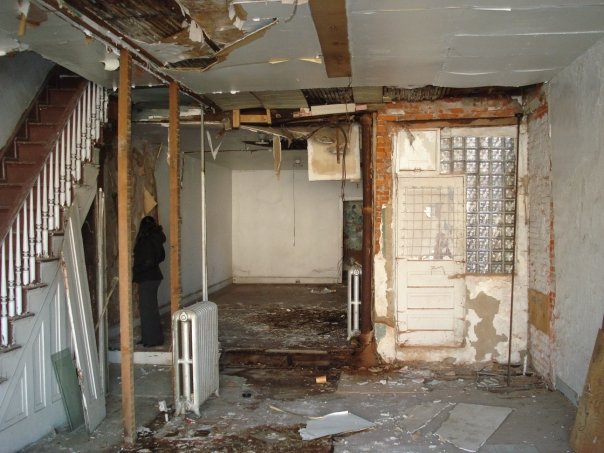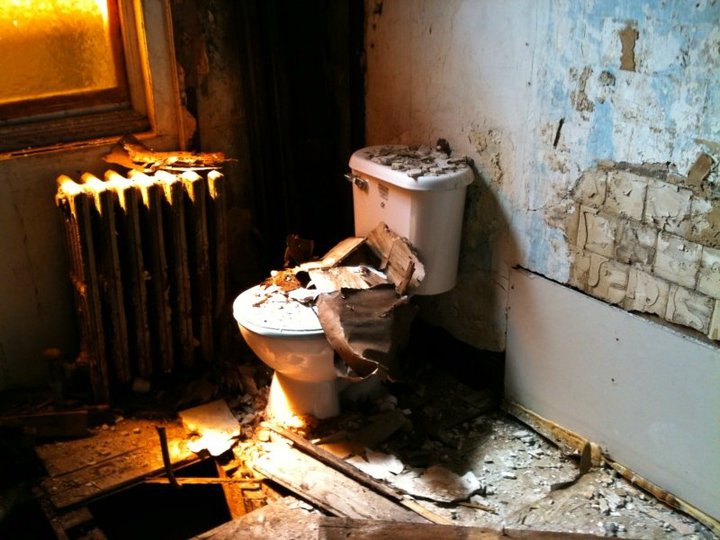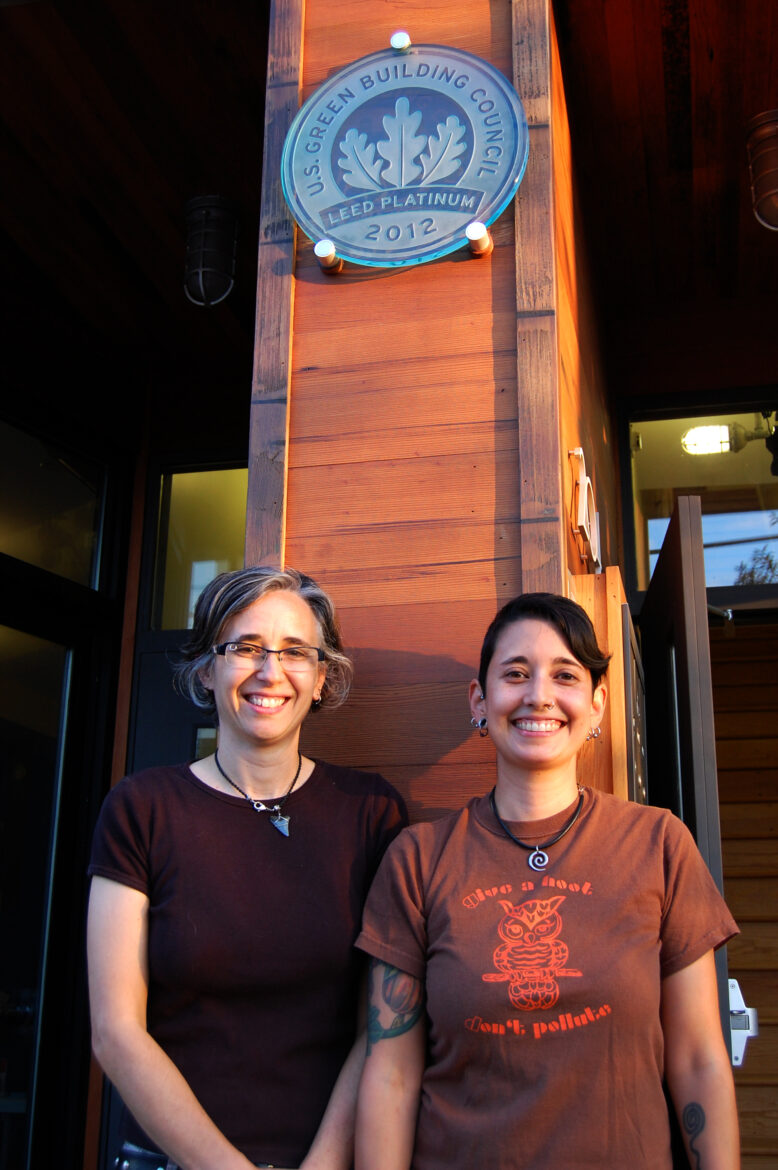
You are so denied, it’s not even funny.
-Suze Orman, The “Can I Afford It” segment on her CNBC show
I figured it was appropriate to start my financial independence writing career with a clickbaity title.
In 2010, Mia and I embarked on a huge real estate development project. It wasn’t on purpose, we tried looking for a nice, move-in ready building for our web development agency with maybe an apartment or two on top. Then I fell in love with two completely dilapidated, vacant, falling down buildings with 3 units each and just had to rescue them.



I love Philadelphia and the opportunity to renovate two 100+ year old buildings was a dream come true! And on top of that, I wanted to do a LEED Platinum rehab (the first mixed-use LEED Platinum rehab in Pennsylvania).
It was a very expensive dream come true.
I HUSTLED and applied to over a dozen banks & lending programs. In the end, we secured a community bank to be the primary lender and a Philly development corporation as the secondary lender. We also had to put in our own money, so we drained our savings, took original contributions out of our ROTH IRAs and got a HELOC on our house.
Suze Orman had a segment on her CNBC show called Can I Afford It? Mia and I would joke if we went on and described our real estate project to her she would SO deny us.
Things got even more expensive
Typical of all construction projects, scope creep came for us. It felt like every week a structural engineer delivered bad news and a new expense got piled on top. I was determined to reach LEED Platinum and nothing less, and as we scrambled for the final points needed, every point was a change order.
We ran out of money quickly so I took out more debt — personal lines of credit, credit cards, a loan from my brother, etc. By the time all was said and done we racked up around $170K of personal debt.
We are not debt people!
Mia and I never kept any personal debt (except our home mortgage) and now we had $170K of it! It made me feel sick and I was determined to pay it down as quickly as possible.
How We Paid Off $170K of Debt in 10 Years
1. I made a spreadsheet
I made a spreadsheet and listed every lender, with columns for lendee, amount owed, credit line (if applicable) and interest rate. Here’s a snapshot of sometime in 2015 (AKA how far back in time Google Sheets will let me go).
| Person | Bank | Amount Owed | Credit Line | Available | % Rate |
|---|---|---|---|---|---|
| Mia | Credit Card 1 | $6,600 | $14,000 | $7,400 | 18.99% |
| Mia | Credit Card 2 | $12,700 | $16,200 | $3,500 | 13.99% |
| Mia | Credit Card 3 | 0 | $8,000 | $8,000 | 12.99% |
| Mia | Bank LOC | 0 | $15,000 | $15,000 | 13.40% |
| Tracy | Credit Card 1 | 0 | $10,500 | $10,500 | 18.99% |
| Tracy | Credit Card 2 | $11,600 | $15,900 | $4,300 | 13.99% |
| Tracy | Bank LOC | 0 | $15,000 | $15,000 | 13.40% |
| Tracy | Credit Card 3 | 0 | $4,200 | $4,200 | 12.99% |
| Both | Gregory (My Brother) | $16,600 | n/a | 0 | 0 |
| Both | Bank Home Loan | $36,681 | n/a | 0 | 4.99% |
With this I could quickly see which lender had the highest interest rate so I could prioritize paying those off first.
I also did things like make the ones paid off green and the ones we still owed money on red. It automatically calculated the total owed, so I would get a little high every time I’d make a payment and see the number go down.
2. We worked zero interest transfer balances
If we kept these balances on our credit cards with the high interest rates they charge, we would be paying them off for decades to come. So I used zero interest checks from one credit card to pay off another. I would only pay the fee to use the check (just a few hundred dollars) and work on paying off the balance interest-free. To keep track of this I added 2 columns to the spreadsheet — the amount covered by a zero interest transfer and the date the zero interest rate expired.
| Person | Bank | Amount Owed | Credit Line | Available | % Rate | 0% Amount | 0% End Date |
|---|---|---|---|---|---|---|---|
| Mia | Credit Card 1 | $6,600 | $14,000 | $7,400 | 18.99% | 100% | 12-2015 |
| Mia | Credit Card 2 | $12,700 | $16,200 | $3,500 | 13.99% | $11960 / $3600 | 7-2015 / 8-2015 |
| Mia | Credit Card 3 | 0 | $8,000 | $8,000 | 12.99% | ||
| Mia | Bank LOC | 0 | $15,000 | $15,000 | 13.40% | ||
| Tracy | Credit Card 1 | 0 | $10,500 | $10,500 | 18.99% | ||
| Tracy | Credit Card 2 | $11,600 | $15,900 | $4,300 | 13.99% | 100% | 1-2016 |
| Tracy | Bank LOC | 0 | $15,000 | $15,000 | 13.40% | ||
| Tracy | Credit Card 3 | 0 | $4,200 | $4,200 | 12.99% | ||
| Both | Gregory (My Brother) | $16,600 | n/a | 0 | 0 | ||
| Both | Bank Home Loan | $36,681 | n/a | 0 | 4.99% |
Before the 0% interest rate expired I would shuffle the money around again and do a new zero interest transfer until one by one all the cards were paid off.
This took A LOT of discipline. If I was the kind of person who easily got into credit card trouble this wouldn’t have worked. I never used these cards for any new purchases. The credit card companies still made money off me in transfer fees, but it’s a drop compared to paying their high interest rates.
3. We prioritized paying back my brother
A good rule to follow is never lend money to friends or family. So often I’ve seen people lend money to family members and never get paid back. It can ruin relationships or make things super tense. I DID NOT want to be that guy, so we treated the loan from my brother like a loan from a financial institution. From the beginning I made payments to him every month. I even made a little receipt showing the payment history and balance owed. As I paid off the other debts I made the payments to him larger. Making the final payment to him felt better than it did to any of the other lenders.
4. We paid down the debt as aggressively as possible
While we were in debt payment mode we lived frugally. We didn’t do big vacations or take on any large expenses. On the downside, we didn’t save a lot either. We still made monthly contributions to our IRAs and our kid’s 529, but it wasn’t close to maxed out like we did before buying the buildings. It was definitely a financial compromise but I just hated being in debt.
5. We used income from the rental units to pay off debt quicker
Remember those buildings that got us into debt to begin with? Well, they made us landlords and positive cash flow started to come in. We used that money to pay down debt and cover unexpected expenses.
6. We threw surprise money at the debt
Tax refund? Use it to pay debt. Work bonus? Throw it at the debt. Any unexpected income that came our way went to debt. It felt great to pay off bigger chunks at a time.
Was it Worth the Struggle?

Now that were done paying off $170K of debt in 10 years, was it worth it?
- Having lived in Philadelphia since 1988, I knew Fishtown, the neighborhood the buildings were in, was going to blow up. And indeed Forbes named it “America’s Hottest New Neighborhood” in 2018.
- From the start, we netted more in rental income than our projections. We very rarely have a vacancy, and the last time a tenant left, the unit was filled in 1 day.
- Last summer, I refinanced the mortgage with a great interest rate and absorbed the secondary loan into the primary one bringing our monthly loan payment down significantly.
- For the refi we had a new appraisal done and it appraised for WAY higher than when we bought it. We now own 42% of the buildings, and of course, I pay extra towards the principal each month (I made sure there were no prepayment penalties when we did the refi).
- The buildings bring in a healthy positive cash flow each month, and while there’s often a leak to repair or HVAC unit to fix, the buildings now contribute to our savings instead of debt.

Did we miss out on 10 years of maxing out our IRAs? Sure, but owning these buildings and contributing to The City of Philadelphia, Fishtown and the environment is important to me.
The building project got a lot of press, won awards and the Mayor gave a speech at our Open House.
Suze would have denied us, but sometimes, if you feel it’s worth it in your gut, you have to take a risk.

1 thought on “How We Paid Off $170,000 of Debt in 10 Years”